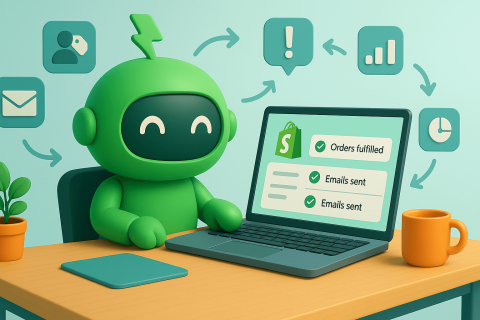
Running a Shopify store takes time, unless you build it to virtually run itself. With the right workflows in place, you can automate everything from fulfillment alerts to loyalty tagging without hiring extra help or adding manual busywork to your day.
Shopify gives you a few built-in tools to get started. But to create a store that truly operates on autopilot, you’ll need something more powerful. In this guide, we’ll walk through how to set up a (nearly) fully automated Shopify store, one step at a time.
Start with the right foundation
Before you dive into workflows, it helps to understand what Shopify gives you out of the box. On any paid plan, you’ll get access to Shopify Flow — a visual builder that lets you create basic automation based on store events.
Flow is useful for tagging customers after purchase, auto-cancelling high-risk orders, or notifying your team when certain SKUs are ordered. But it’s limited. You can’t send HTML emails, schedule delayed actions, or connect to third-party systems unless they’ve built specific integrations.
That’s why most merchants use Flow for simple triggers — and bring in apps like Arigato when they’re ready to go deeper.
Identify the tasks you want to automate
No store needs to automate everything at once. Start by looking at the manual tasks you repeat every day. These usually fall into a few categories.
For order and fulfillment workflows, you might want to tag certain orders, notify your team if specific products are purchased, or follow up when an order remains unfulfilled for too long. These small alerts can prevent issues before they snowball.
Customer communication is another high-impact area to look into. You can send personalized welcome emails, tag customers after their third purchase, or follow up after a delay in fulfillment. Automating these steps improves retention and keeps the experience consistent.
Don't forget about product and inventory workflows helping behind the scenes though. You can tag items when inventory drops below a threshold, set a metafield when a product sells out, or unpublish products after a certain date. These workflows keep your catalog clean without constant admin work.
And finally, marketing automation lets you engage customers without reinventing every campaign. You can segment VIPs, tag seasonal shoppers, or notify subscribers about new launches based on behavior — not guesswork.
Use Arigato to build smart, custom workflows
Arigato is a workflow automation app that connects deeply with your Shopify store. It gives you more control over what triggers an action, how logic is applied, and what steps come next.
You can create workflows that run when customers are updated, orders are tagged, or metafields are modified. You can delay actions until a product is fulfilled, or schedule workflows to run daily or weekly. With support for custom filters, loops, fallback values, and conditional logic, your automation can match your business rules exactly.
You can also send fully formatted HTML emails, push data to Airtable or Google Sheets, notify vendors, update tags, or create tasks in external tools like Trello or Slack. And because Arigato includes a library of 300+ Shopify automation templates, you don’t have to start from zero.
Build one workflow at a time
Automation doesn’t have to happen all at once. Start with a single workflow — maybe tagging customers when they cross a spend threshold, or sending an email when a large order is placed. Run it in test mode, tweak the logic, and review the logs to make sure it’s firing correctly.
Once that’s running smoothly, build the next one. Over time, your store becomes more self-sufficient — and you spend less time reacting to tasks that could be automated.
Monitor and refine
Even the best workflows need updates over time. Arigato includes logging and test modes so you can monitor what’s running, spot any issues early, and adjust logic as your store evolves.
This might mean changing your tagging logic as your product catalog grows, adjusting triggers for seasonal promotions, or fine-tuning email content based on customer feedback.
Automate a Shopify store TL;DR
You don’t need to write code, build a custom backend, or hire a developer to create a self-operating Shopify store. You just need the right tools.
With Arigato Automation, you can automate the tasks that slow you down, from fulfillment alerts to loyalty segmentation, and build a store that runs the way you work.
Start with one workflow. Then another. Soon your store will feel nearly effortless.